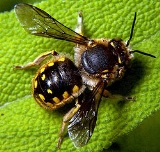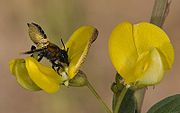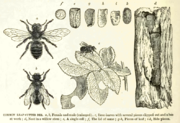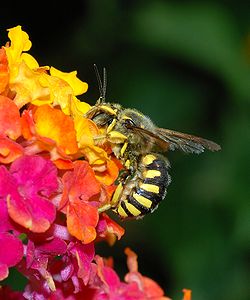
Megachilidae
Encyclopedia

Bee
Bees are flying insects closely related to wasps and ants, and are known for their role in pollination and for producing honey and beeswax. Bees are a monophyletic lineage within the superfamily Apoidea, presently classified by the unranked taxon name Anthophila...
s whose pollen-carrying structure (called a scopa
Scopa (biology)
The term scopa is used to refer to any of a number of different modifications on the body of a non-parasitic bee that form a pollen-carrying apparatus. In most bees, the scopa is simply a particularly dense mass of elongated, often branched, hairs on the hind leg...
) is restricted to the ventral surface of the abdomen (rather than mostly or exclusively on the hind legs as in other bee families). Megachilid genera are most commonly known as mason bee
Mason bee
Mason bee is a common name for species of bees in the genus Osmia, of the family Megachilidae. They are named from their habit of making compartments of mud in their nests, which are made in hollow reeds or holes in wood made by wood boring insects....
s and leafcutter bees, reflecting the materials they build their nest cells from (soil or leaves, respectively); a few collect plant or animal hairs and fibers, and are called carder bees. All species feed on nectar and pollen, but a few are cleptoparasites (informally called "cuckoo bee
Cuckoo bee
The term cuckoo bee is used for a variety of different bee lineages which have evolved the kleptoparasitic habit of laying their eggs in the nests of other bees, reminiscent of the behavior of cuckoo birds. The name is technically best applied to the apid subfamily Nomadinae...
s"), feeding on pollen collected by other megachilid bees. Parasitic species do not possess a scopa. The brightly colored scopa leads to a colloquial name used occasionally in North America - "Jelly-belly bees." Megachilid bees are among the world's most efficient pollinator
Pollinator
A pollinator is the biotic agent that moves pollen from the male anthers of a flower to the female stigma of a flower to accomplish fertilization or syngamy of the female gamete in the ovule of the flower by the male gamete from the pollen grain...
s because of their energetic swimming-like motion in the reproductive structures of flowers, which moves pollen
Pollen
Pollen is a fine to coarse powder containing the microgametophytes of seed plants, which produce the male gametes . Pollen grains have a hard coat that protects the sperm cells during the process of their movement from the stamens to the pistil of flowering plants or from the male cone to the...
, as needed for pollination
Pollination
Pollination is the process by which pollen is transferred in plants, thereby enabling fertilisation and sexual reproduction. Pollen grains transport the male gametes to where the female gamete are contained within the carpel; in gymnosperms the pollen is directly applied to the ovule itself...
. One of the reasons they are efficient pollinators is their frequency of visits to plants, but this is because they are extremely inefficient at gathering pollen; compared to all other bee families, megachilids require on average nearly ten times as many trips to flowers to gather sufficient resources to provision a single brood cell.
North America has many native megachilid species, but Alfalfa leafcutter bee
Alfalfa leafcutter bee
Megachile rotundata, the alfalfa leafcutter bee or lucerne leafcutter bee is a European bee that has been introduced to other regions...
s (Megachile rotundata) are an imported species used for pollination
Pollination management
Pollination Management is the label for horticultural practices that accomplish or enhance pollination of a crop, to improve yield or quality, by understanding of the particular crop's pollination needs, and by knowledgeable management of pollenizers, pollinators, and pollination...
. The most significant native species is Osmia lignaria (the "Orchard Mason Bee
Orchard mason bee
Osmia lignaria, commonly known as the orchard mason bee or blue orchard bee, is a megachilid bee that makes nests in reeds and natural holes, creating individual cells for their brood that are separated by mud dividers. Unlike carpenter bees, they cannot drill holes in wood. O...
" or "Blue Orchard Bee
Orchard mason bee
Osmia lignaria, commonly known as the orchard mason bee or blue orchard bee, is a megachilid bee that makes nests in reeds and natural holes, creating individual cells for their brood that are separated by mud dividers. Unlike carpenter bees, they cannot drill holes in wood. O...
"), which is sold commercially for use in orchard crop pollination, and which can be attracted to nest in wooden blocks with holes drilled in them (which are also sold commercially for this purpose).
Non-parasitic species
The general life cycle of non-parasitic Megachilidae is as follows (but see below for variations):
Variations:
- Nests are often (but not always) built in natural or artificial cavities. Some embed individual cells in a mass of clay or resin attached to a wall, rock surface, or plant stem.
- Nest cavities are often linear, for example in hollow plant stems, but not always (snail shells are used by some Osmia, and some species will readily use irregular cavities).
Parasitic species
Some genera of Megachilids are brood parasites and, therefore, have no ventral scopa (e.g. Stelis, Coelioxys). They often parasitize related taxa. They typically enter the nest before it is sealed and lay their eggs in a cell. After hatching, the parasite larva kills the host larva, unless the female parasite has already done so, and then consumes the provisions. Parasitic species are of equal size or smaller than their victims.Genera of Megachilidae

- AnthidiumAnthidiumAnthidium is a genus of bees often called mason or potter bees, who use conifer resin, plant hairs, mud, or a mix of them to build nests. They are in the family Megachilidae which is cosmopolitan in distribution and made up of species that are mostly solitary bees with pollen-carrying scopea that...
- Anthidiellum
- Ashmeadiella
- Coelioxys are brood parasites of MegachileMegachileThe genus Megachile is a cosmopolitan group of solitary bees, often called leafcutter bees. While other genera within the family Megachilidae may chew leaves or petals into fragments to build their nests, certain species within Megachile neatly cut pieces of leaves or petals, hence their common name...
. Females have a pointed conic abdominal apex (tip), males have several spikes on their apex. - Dianthidium
- Dioxys are brood parasites of MegachileMegachileThe genus Megachile is a cosmopolitan group of solitary bees, often called leafcutter bees. While other genera within the family Megachilidae may chew leaves or petals into fragments to build their nests, certain species within Megachile neatly cut pieces of leaves or petals, hence their common name...
, AnthidiumAnthidiumAnthidium is a genus of bees often called mason or potter bees, who use conifer resin, plant hairs, mud, or a mix of them to build nests. They are in the family Megachilidae which is cosmopolitan in distribution and made up of species that are mostly solitary bees with pollen-carrying scopea that...
and Osmia. - Heriades are mason bees with narrow abdominal bands. They resemble small Osmia, but they are oligolectic (specialized on a few subfamilies of AsteraceaeAsteraceaeThe Asteraceae or Compositae , is an exceedingly large and widespread family of vascular plants. The group has more than 22,750 currently accepted species, spread across 1620 genera and 12 subfamilies...
) and use resin from conifers, as well as plant fibers and sand, as cell wall material. - Heterostelis are parasitic on Trachusa.
- Hoplitis
- MegachileMegachileThe genus Megachile is a cosmopolitan group of solitary bees, often called leafcutter bees. While other genera within the family Megachilidae may chew leaves or petals into fragments to build their nests, certain species within Megachile neatly cut pieces of leaves or petals, hence their common name...
- Osmia
- Paranthidium
- Rhodanthidium
- Stelis Panzer and related genera (stelidine bees) are cleptoparasites on other Megachilidae. They belong to the tribe Anthidiini.
- Trachusa
External links
- Palaearctic Osmiine Bees
- leafcutting bees on the UFUniversity of FloridaThe University of Florida is an American public land-grant, sea-grant, and space-grant research university located on a campus in Gainesville, Florida. The university traces its historical origins to 1853, and has operated continuously on its present Gainesville campus since September 1906...
/ IFASInstitute of Food and Agricultural SciencesThe University of Florida’s Institute of Food and Agricultural Sciences is a federal-state-county partnership dedicated to developing knowledge in agriculture, human and natural resources, and the life sciences, and enhancing and sustaining the quality of human life by making that information...
Featured Creatures Web site - Online Guides to all the eastern North American Megachilidae
- Bugguide. Information and photos of Mechalidae of North America

